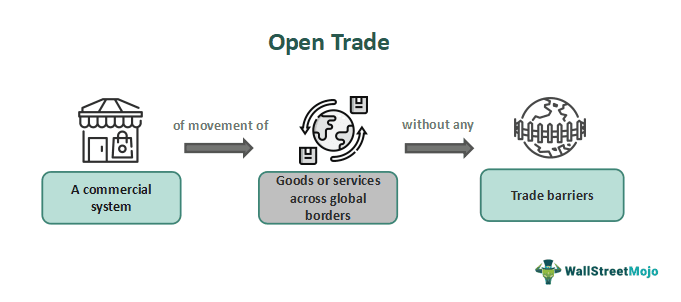Table of Contents
Open Trade Meaning
Open trade refers to the exchange of services or goods between nations with minimal restrictions and barriers. This practice leads to increased efficiency and economic growth. It leads to job creation, innovation, and enhanced competitiveness, ultimately elevating people's living standards.

In open trade, barriers are eliminated or reduced between nations. The US has multiple free trade agreements with approximately 20 countries. These agreements are crucial for the American economy, as they enable businesses to produce goods and services that drive economic growth through demand and supply, leading to job creation and market expansion.
Key Takeaways
- Open trade means the interchange of products and services amongst countries without any trade barriers, such as tariffs or quotas. This promotes productivity and economic expansion.
- It contributes to higher standards of living by enhancing innovation and competitiveness, fostering economic growth, and job creation.
- It provides easy access to goods and reduces costs. In addition, it offers benefits to consumers and leads to global collaboration.
- In open trade, trade barriers may be reduced to protect local industries, whereas in free trade, there are generally no barriers to international trade except for concerns related to public health and national security.
Open Trade Explained
Open trade refers to a commercial system where services and goods move across global borders with minimal trade barriers such as restrictions, quotas, or tariffs. It encourages the exchange of services and goods among nations based on comparative advantage. Furthermore, various multilateral agreements, such as those of the World Trade Organization (WTO), govern this trade.
Such a trade operates on the principle of comparative advantage. This implies that both trading nations can gain from trade even if one is more productive than the other in producing all commodities. When each country specializes in producing goods where they have a comparative advantage, it results in enhanced efficiency and greater overall welfare for both nations.
Moreover, it allows nations to concentrate more on their strengths. This leads to increased productivity and optimal resource allocation. However, it may require adjustment to changing situations, such as transitions in comparative advantages due to shifts in market volatility and technological progress. It needs to be accompanied by suitable trade policies to help businesses seeking to expand internationally because they offer larger markets and diversified resources access. Additionally, consumers can buy and experience different varieties of goods at affordable prices.
Such trading policies have a profound impact on the financial world, particularly on financial markets like open trade markets. It shapes global economic trends and provides investment opportunities for businesses. Furthermore, it can influence stock market efficiency and currency exchange rates. This helps stabilize the overall international financial framework.
Many traders use Saxo Bank International to research and invest in stocks across different markets. Its features like SAXO Stocks offer access to a wide range of global equities for investors.
Examples
Let us take the help of a few examples to understand the topic.
Example #1
Let us assume a country called XYZ has implemented open trade policies with other countries. It has technological prowess, while its trading partners have advanced agricultural methods and produce farming products in huge amounts. As they have a comparative advantage with each other, they can share each other's strengths and get benefits.
In addition, XYZ has advanced technological sectors, which can be exchanged with other nations for seafood, shrimp products, dairy products, and cereals. Upon finalizing the trade agreements with these nations, Atlantica can leverage its strengths to stimulate job creation, advance its economy, and satisfy the nutritional needs of its population.
Example #2
An online article published on 13 May 2024 discusses about 20th anniversary of the free trade agreement between the US and Singapore (US-Singapore FTA). The article emphasizes successful trading relations despite differing approaches to open trade policies. While Singapore prioritizes trade by engaging in various agreements such as RTEP & CTPP, the US focuses on market-opening dialogues.
However, the US Congress has historically approved many trade deals with different countries like Korea and Peru, highlighting its political and public support for trade. As a result of these deals, the US has been able to boost its exports and jobs substantially. Further, the US-Singapore FTA facilitated $82 billion in trade of goods the previous year, exemplifying fruitful economic involvement demanding the US deepen ties with Southeast Asia.
Benefits
There are several benefits of an open trade system, including:
- Economic prosperity – It promotes prosperity and economic growth in nations, leading to job creation and poverty eradication.
- Consumer benefits – It ascertains the customers of the trading nations have easy and wide access to a larger number of goods at competitive and affordable prices.
- Global collaboration- It leads to collaboration amongst nations on all issues. This leads to breakthroughs in technologies and health care, ultimately helping the global population.
- Cost efficiency- It reduces the expenses of raw materials, components and resources needed for the production of goods, leading to cost reduction in production.
- Competition and innovation- It provides wider access to markets. This fosters competition and encourages technological advancement, ultimately leading to the provision of better services and goods.
- Avoiding trade barriers- It mitigates the negative impacts caused by barriers such as tariffs, which can increase production costs, raise product prices, and disrupt global supply chains.
Open Trade Vs. Free Trade
Let us know the difference between the two using the table below:
| Open Trade | Free Trade |
|---|---|
| It reduces trade barriers to a great extent and saves local industries. | No barriers to international trade except for public health and national security |
| It may include quotas, tariffs, or subsidies for domestic industries. | No such protections for local industries. |
| It has more trade restrictions than free trade | The highest degree of international trade freedom. |
| It increases competition amongst producers so consumers get goods at affordable prices. | This may lead to job losses with lower goods costs and access to a variety of goods. |
| It may create jobs in some sectors. | This may lead to environmental concerns. |
Disclosure: This article contains affiliate links. If you sign up through these links, we may earn a small commission at no extra cost to you.

